#coding arduino
Explore tagged Tumblr posts
Text
I made an output agnostic logging framework for embedded devices that would work on anything as it's written only with standard C++ libs. In theory I could use it for linux or pis, lol. I made it because I kept having to write new handlers for serial, mqtt, uart, then having to like wire them all together without creating dependency loops or other issues - especially because I often work on meshes or online embedded devices that require multiple outputs. Now you just write your handler, tell it what tags to watch, and it'll log according to tag and log level. So you could write a serial debugging log handler when you're first making it. Then when you're done, disable it, and it'll stop outputting - but then later assign the serial debugging log tag to your MQTT handler and get all your debugging serial lines output to MQTT - then just disable it again when you're done. There's still some polish I need to put into it, it has some jank, some bugs, but it's working and neat. it's kind of neat.
39 notes
·
View notes
Text
TLV320DAC3100 first bops 🔊🎶💃🕺
OK, after many hours spent with Claude on writing a driver for the TLV320DAC3100 (https://www.digikey.com/en/products/detail/texas-instruments/TLV320DAC3100IRHBR/2260591), we finally have it configured using our driver, and playing an MP3 stream on this ESP32. This I2S DAC has a particularly complex PLL and audio-routing system, so it's not one where you can just pipe in I2S data and have it magically play. One nice thing we got working on is the MCLK, which is generated from the BCLK, so it'll work great with anything from an Arduino-compatible to a single-board computer like Raspberry Pi. We're hoping to get the headphone detection working next so that we can turn off the amp when the headphone is plugged in. Also, it should be able to control the volume from the headset buttons. Also, we want to get the internal beep generator going so we can make tones separate from the audio stream for UI notifications.
#tlv320dac3100#dac#esp32#i2s#audioengineering#opensource#mp3streaming#embeddedhardware#hardwarehacking#arduino#raspberrypi#microcontrollers#firmware#coding#electronics#headphones#pll#audioprocessing#dsp#mclk#bclk#headphonemod#techinnovation#audiophile#sounddesign#makercommunity#opensourcehardware#iot#embeddeddev#beepgenerator
36 notes
·
View notes
Text
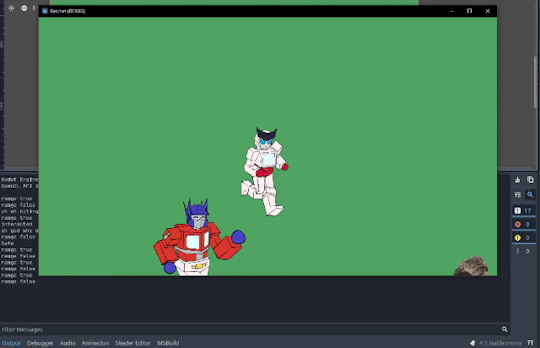
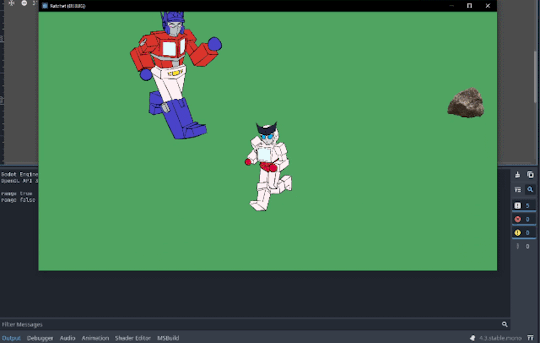
Trying to get back into game dev, so I practiced using the bois
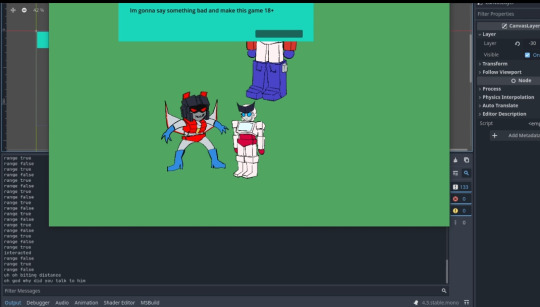
I've made some dating sims as a joke for me and my friends + some actual games in unity but I haven't touched it since that whole debacle last year, so I've been meaning to get into Godot, the only problem is that Godot has their own language and I like using C#, and although they have improved their support for it, all of the tutorials use Godot Script or whatever so I have to actually read the documentation. I miss the unity UI creation and gameobjects, still getting used to the node system
Trying to program their movements is pretty interesting though, rn it's way too smooth but this could work for their alt mode, like when you press and hold shift they can transform into their alt
(Hasboro I'm just practicing on Godot don't sue me)
#i miss doing gamejams#i have an arduino ive been thinking of hooking it up to one of my figurines and making it move#i cant find it tho rip#just a lil something that isnt art#transformers#transformers fanart#transformers g1#ratchet#starscream#maccadams#optimus prime#coding#i dont know why this posted it was supposed to save to drafts first oops oh well#imagine if i put transformers dating sim on my resume... and then applied to hasboro#amazing bit
87 notes
·
View notes
Text
Desperately trying to find the tech AV/robotics/coding community of tumblr.
WHERE ARE YOU. PLEASE. GIVE ME LIFE. HEAR MY HASHTAGS AND FIND ME.
#tech crew#tech#audiovisual#theatre#backstage#backstage drama#lighting#robotics#coding#programming#developers#engineering#rusty the steam engine#c++#c++ programming#python#arduino#computing
10 notes
·
View notes
Text
arduino goose
i am thinking of making an animatronic war goose...kevin smiting will be much easier with eye tracking lasers--hehehhehehehheh--blindness will not bode well for kevin
5 notes
·
View notes
Text
I finished version 1 of my worry eater. Right now it is thinking about how I am a fuckup who destroys everything she touches, and that's why everyone hates me. This frees me up to think about literally anything else! So far it seems to be working pretty good!
5 notes
·
View notes
Text
I AM SO GOOD AT CIRCUIT BUILDING AND PROGRAMMING RAAAAA
C++ script under cut :3
int UpDown; //value for the Y direction of controller
int LeftRight; //value for the x direction of controller
int LR_neutral; //value for the 0 position in the y direction of controller
int UD_neutral; //value for the 0 position in the x direction of controller
int Bprev; //value for button edge detection
int Bcurr; //value for button edge detection
int R;
int Y;
int G;
int B;
void setup() {
Serial.begin(9600); //begin communication
pinMode(A2, INPUT); //button press detection
pinMode(4, OUTPUT); //set pin 4 to power the Red LED
pinMode(5, OUTPUT); //set pin 5 to power the Yellow LED
pinMode(6, OUTPUT); //set pin 6 to power the Blue LED
pinMode(7, OUTPUT); //set pin 7 to power the Green LED
LR_neutral = analogRead(A1); //set zero position of controller
UD_neutral = analogRead(A0); //set zero position of controller
//WARNING!!! YOU CAN NOT TOUCH CONTROLER WHEN INITALIZATION HAPPENS!!!! WILL MESS CONTROLLER UP
}
void loop() {
LeftRight = analogRead(A0); //read X position of controller
UpDown = analogRead(A1); //read y position of controller
Bprev = Bcurr; //set current button state to previous state
Bcurr = analogRead(A2); //set current button state equal to actual button state
if ((Bprev == 0) && (Bcurr > 0)){
//turns all LED on
digitalWrite(4,HIGH);
digitalWrite(5,HIGH);
digitalWrite(6,HIGH);
digitalWrite (7,HIGH);
delay(100); //wait
//turns all LED off
digitalWrite (4,LOW);
digitalWrite (5,LOW);
digitalWrite (6,LOW);
digitalWrite (7,LOW);
}
if (UpDown >= UD_neutral) { // checks if controller is up
B = 0; //if up turns blue LED off
R = map(UpDown, UD_neutral,1023,0,255); //if up turns red LED on
}
else {
R = 0; //if down turns red LED off
B = map(UpDown, UD_neutral,0,0,255); //if down turns blue LED on
}
if (LeftRight >= LR_neutral) { // checks if controller is right
G = 0; //if right turns green LED off
Y = map(LeftRight, LR_neutral, 1023,0,255); //if right turns yellow LED on
}
else {
Y = 0; //if left turns yellow off
G = map(LeftRight, LR_neutral, 0,0,255); //if left turns green on
}
//writes values to LEDs
analogWrite(4,R);
analogWrite(5,Y);
analogWrite(6,B);
analogWrite (7,G);
}
#Do you want to learn C++#because I know C++#people who know what they are doing know that this code has several issues tho :/#but it works!!!#And I'll take that#programing#circuit diagram#curcuits#prototype circuit#arduino#I'M GONNA MAKE A ROBOT AND NO ONE CAN STOP ME#yes this is unironically my homework#I love college!
5 notes
·
View notes
Text

This is the first set up for the smart meter (the physical build that is). I copied down some basic code to make it work and removed the screen until I know I can make it work. While the code is running well and the sensor seems to be working (it responded to when I open and close it), I still have yet to read the AC current of cords successfully.
I tried reading the current going through my lava lamp and a few other cords in my room without success, but I’m still optimistic about it working. I just need to re-review the code and make sure I choose actual AC devices to test it on.
6 notes
·
View notes
Text
Robotics Training
In the technologically advanced world of today, robotics has become a crucial sector that is reshaping industries and developing novel answers to difficult problems. Training in robotics has become crucial for both individuals and companies hoping to succeed in this ever-changing field. From novices to experts, systematic robotics instruction gives students the tools they need to efficiently design, program, and manage robotic systems.
The Importance of Robotics Training
Training in robotics helps close the gap between theory and real-world implementation. Understanding robotics is now essential as automation and artificial intelligence become more pervasive in industries including manufacturing, healthcare, agriculture, and logistics.
Types of Robotics Training Programs
Beginner Courses
Advanced Training
Industry-Specific Training
Certifications and Diplomas
Benefits of Robotics Training
Improved Opportunities for Careers:
Experts in robotics are highly sought after in a variety of businesses.
Certification programs enhance employment opportunities and give resumes more legitimacy.
Creativity & Innovation:
Learning robotics inspires students to think creatively and develop ground-breaking technology.
Practical Education:
Training programs have a strong emphasis on hands-on experience, enabling students to construct working robots and work on real-world projects.
Teamwork:
Interdisciplinary collaboration is common in robotics, which promotes communication and teamwork abilities.
Popular Robotics Training Platforms
Coursera and edX
Udemy and Skillshare
VEX Robotics and FIRST Robotics
University Programs
Learning robotics is more than just becoming proficient with technology; it's about getting ready for a time when automation and robots will be a big part of our everyday life. Investing in robotics training can result in rewarding opportunities and a happy career, regardless of whether you're a professional trying to advance your skills or a student hoping to enter the sector. Maintaining your edge with the correct training will enable you to participate in this revolutionary journey as robotics continues to advance.
To know more, click here.
3 notes
·
View notes
Text
not now kitten daddy's code is screwed and he needs a second pair of eyes to look over it
#personal#thinking abt my last post. this is me whenever i need to code something for the arduino.#when i graduate i better not see a fucking microcontroller else im going to [REDACTED]
2 notes
·
View notes
Text

My nano which I bought with my own money:
2 notes
·
View notes
Text
The first test for our WLED board codename "Sparkle Motion" 🌈💖💡 … 🐇⏳🌌
We got our WLED-friend PCBs today, and we only made one mistake: the wrong resistor on the 3.3V feedback line. Now that it's fixed, the board seems to work great with the latest version of WLED
We are checking all 4 signal outputs with this handy 256-LED grid that sits on our desk. Next, we will test the onboard IR receiver, USB PD, I2S microphone, extra I/O pins, and I2C. We'll also do an Arduino IDE board definition in case folks want to use it as a generic ESP32-to-LED-driver board. We're calling the board "Sparkle Motion" for now, but if you have other naming ideas, let us know - if we pick your name, you get a free board
Sign up, coming soon.
#wled#sparklemotion#leddriver#esp32#electronics#pcbs#arduino#makerprojects#openhardware#opensource#coding#leds#hardwaredesign#innovation#techgeeks#smartlighting#microcontrollers#hardwareengineering#esp32projects#ledmatrix#diyhardware#iotprojects#arduinoide#hardwaretesting#ledtechnology#techmakers#electronicscommunity#prototyping#hardwarehacking#adventuresintech
17 notes
·
View notes
Text
Mastering Neural Networks: A Deep Dive into Combining Technologies
How Can Two Trained Neural Networks Be Combined?
Introduction
In the ever-evolving world of artificial intelligence (AI), neural networks have emerged as a cornerstone technology, driving advancements across various fields. But have you ever wondered how combining two trained neural networks can enhance their performance and capabilities? Let’s dive deep into the fascinating world of neural networks and explore how combining them can open new horizons in AI.
Basics of Neural Networks
What is a Neural Network?
Neural networks, inspired by the human brain, consist of interconnected nodes or "neurons" that work together to process and analyze data. These networks can identify patterns, recognize images, understand speech, and even generate human-like text. Think of them as a complex web of connections where each neuron contributes to the overall decision-making process.
How Neural Networks Work
Neural networks function by receiving inputs, processing them through hidden layers, and producing outputs. They learn from data by adjusting the weights of connections between neurons, thus improving their ability to predict or classify new data. Imagine a neural network as a black box that continuously refines its understanding based on the information it processes.
Types of Neural Networks
From simple feedforward networks to complex convolutional and recurrent networks, neural networks come in various forms, each designed for specific tasks. Feedforward networks are great for straightforward tasks, while convolutional neural networks (CNNs) excel in image recognition, and recurrent neural networks (RNNs) are ideal for sequential data like text or speech.
Why Combine Neural Networks?
Advantages of Combining Neural Networks
Combining neural networks can significantly enhance their performance, accuracy, and generalization capabilities. By leveraging the strengths of different networks, we can create a more robust and versatile model. Think of it as assembling a team where each member brings unique skills to tackle complex problems.
Applications in Real-World Scenarios
In real-world applications, combining neural networks can lead to breakthroughs in fields like healthcare, finance, and autonomous systems. For example, in medical diagnostics, combining networks can improve the accuracy of disease detection, while in finance, it can enhance the prediction of stock market trends.
Methods of Combining Neural Networks
Ensemble Learning
Ensemble learning involves training multiple neural networks and combining their predictions to improve accuracy. This approach reduces the risk of overfitting and enhances the model's generalization capabilities.
Bagging
Bagging, or Bootstrap Aggregating, trains multiple versions of a model on different subsets of the data and combines their predictions. This method is simple yet effective in reducing variance and improving model stability.
Boosting
Boosting focuses on training sequential models, where each model attempts to correct the errors of its predecessor. This iterative process leads to a powerful combined model that performs well even on difficult tasks.
Stacking
Stacking involves training multiple models and using a "meta-learner" to combine their outputs. This technique leverages the strengths of different models, resulting in superior overall performance.
Transfer Learning
Transfer learning is a method where a pre-trained neural network is fine-tuned on a new task. This approach is particularly useful when data is scarce, allowing us to leverage the knowledge acquired from previous tasks.
Concept of Transfer Learning
In transfer learning, a model trained on a large dataset is adapted to a smaller, related task. For instance, a model trained on millions of images can be fine-tuned to recognize specific objects in a new dataset.
How to Implement Transfer Learning
To implement transfer learning, we start with a pretrained model, freeze some layers to retain their knowledge, and fine-tune the remaining layers on the new task. This method saves time and computational resources while achieving impressive results.
Advantages of Transfer Learning
Transfer learning enables quicker training times and improved performance, especially when dealing with limited data. It’s like standing on the shoulders of giants, leveraging the vast knowledge accumulated from previous tasks.
Neural Network Fusion
Neural network fusion involves merging multiple networks into a single, unified model. This method combines the strengths of different architectures to create a more powerful and versatile network.
Definition of Neural Network Fusion
Neural network fusion integrates different networks at various stages, such as combining their outputs or merging their internal layers. This approach can enhance the model's ability to handle diverse tasks and data types.
Types of Neural Network Fusion
There are several types of neural network fusion, including early fusion, where networks are combined at the input level, and late fusion, where their outputs are merged. Each type has its own advantages depending on the task at hand.
Implementing Fusion Techniques
To implement neural network fusion, we can combine the outputs of different networks using techniques like averaging, weighted voting, or more sophisticated methods like learning a fusion model. The choice of technique depends on the specific requirements of the task.
Cascade Network
Cascade networks involve feeding the output of one neural network as input to another. This approach creates a layered structure where each network focuses on different aspects of the task.
What is a Cascade Network?
A cascade network is a hierarchical structure where multiple networks are connected in series. Each network refines the outputs of the previous one, leading to progressively better performance.
Advantages and Applications of Cascade Networks
Cascade networks are particularly useful in complex tasks where different stages of processing are required. For example, in image processing, a cascade network can progressively enhance image quality, leading to more accurate recognition.
Practical Examples
Image Recognition
In image recognition, combining CNNs with ensemble methods can improve accuracy and robustness. For instance, a network trained on general image data can be combined with a network fine-tuned for specific object recognition, leading to superior performance.
Natural Language Processing
In natural language processing (NLP), combining RNNs with transfer learning can enhance the understanding of text. A pre-trained language model can be fine-tuned for specific tasks like sentiment analysis or text generation, resulting in more accurate and nuanced outputs.
Predictive Analytics
In predictive analytics, combining different types of networks can improve the accuracy of predictions. For example, a network trained on historical data can be combined with a network that analyzes real-time data, leading to more accurate forecasts.
Challenges and Solutions
Technical Challenges
Combining neural networks can be technically challenging, requiring careful tuning and integration. Ensuring compatibility between different networks and avoiding overfitting are critical considerations.
Data Challenges
Data-related challenges include ensuring the availability of diverse and high-quality data for training. Managing data complexity and avoiding biases are essential for achieving accurate and reliable results.
Possible Solutions
To overcome these challenges, it’s crucial to adopt a systematic approach to model integration, including careful preprocessing of data and rigorous validation of models. Utilizing advanced tools and frameworks can also facilitate the process.
Tools and Frameworks
Popular Tools for Combining Neural Networks
Tools like TensorFlow, PyTorch, and Keras provide extensive support for combining neural networks. These platforms offer a wide range of functionalities and ease of use, making them ideal for both beginners and experts.
Frameworks to Use
Frameworks like Scikit-learn, Apache MXNet, and Microsoft Cognitive Toolkit offer specialized support for ensemble learning, transfer learning, and neural network fusion. These frameworks provide robust tools for developing and deploying combined neural network models.
Future of Combining Neural Networks
Emerging Trends
Emerging trends in combining neural networks include the use of advanced ensemble techniques, the integration of neural networks with other AI models, and the development of more sophisticated fusion methods.
Potential Developments
Future developments may include the creation of more powerful and efficient neural network architectures, enhanced transfer learning techniques, and the integration of neural networks with other technologies like quantum computing.
Case Studies
Successful Examples in Industry
In healthcare, combining neural networks has led to significant improvements in disease diagnosis and treatment recommendations. For example, combining CNNs with RNNs has enhanced the accuracy of medical image analysis and patient monitoring.
Lessons Learned from Case Studies
Key lessons from successful case studies include the importance of data quality, the need for careful model tuning, and the benefits of leveraging diverse neural network architectures to address complex problems.
Online Course
I have came across over many online courses. But finally found something very great platform to save your time and money.
1.Prag Robotics_ TBridge
2.Coursera
Best Practices
Strategies for Effective Combination
Effective strategies for combining neural networks include using ensemble methods to enhance performance, leveraging transfer learning to save time and resources, and adopting a systematic approach to model integration.
Avoiding Common Pitfalls
Common pitfalls to avoid include overfitting, ignoring data quality, and underestimating the complexity of model integration. By being aware of these challenges, we can develop more robust and effective combined neural network models.
Conclusion
Combining two trained neural networks can significantly enhance their capabilities, leading to more accurate and versatile AI models. Whether through ensemble learning, transfer learning, or neural network fusion, the potential benefits are immense. By adopting the right strategies and tools, we can unlock new possibilities in AI and drive advancements across various fields.
FAQs
What is the easiest method to combine neural networks?
The easiest method is ensemble learning, where multiple models are combined to improve performance and accuracy.
Can different types of neural networks be combined?
Yes, different types of neural networks, such as CNNs and RNNs, can be combined to leverage their unique strengths.
What are the typical challenges in combining neural networks?
Challenges include technical integration, data quality, and avoiding overfitting. Careful planning and validation are essential.
How does combining neural networks enhance performance?
Combining neural networks enhances performance by leveraging diverse models, reducing errors, and improving generalization.
Is combining neural networks beneficial for small datasets?
Yes, combining neural networks can be beneficial for small datasets, especially when using techniques like transfer learning to leverage knowledge from larger datasets.
#artificialintelligence#coding#raspberrypi#iot#stem#programming#science#arduinoproject#engineer#electricalengineering#robotic#robotica#machinelearning#electrical#diy#arduinouno#education#manufacturing#stemeducation#robotics#robot#technology#engineering#robots#arduino#electronics#automation#tech#innovation#ai
4 notes
·
View notes
Text
Local Guy Successfully Interacts With Contraption
#another lab mailed me an apparatus#i had no expectations for my capacity to operate the apparatus but it turns out that uh#when someone sends you prewritten code to run an arduino that only needs to control one dimension of one motor#you can just run the code. it all works fine.#really absolutely nothing to be done i got it all worked out in like 2 hrs of combined testing and setup incl sterilizing everything#now of course the actual troubleshooting will be if for some reason my tissues are different from the ones theyve tested#e.g. hate to grow on silanized things (won't happen)#or rupture in response to insult (could happen but also these cells are not actually very fragile)#but that part is my actual job. which troubleshooting an arduino is not.#so that part i feel less completely unable to make predictions about#anyway. guy can plug 2 things in. big news! big cool exciting news for everybody#box opener
6 notes
·
View notes
Text
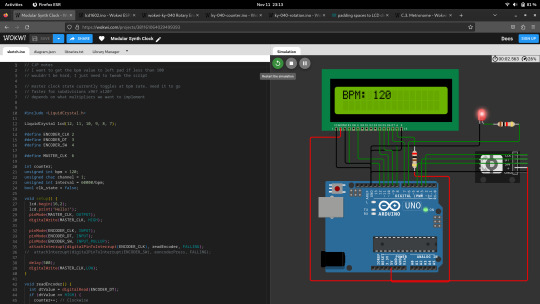
Clock module algorithm design has officially begun! I'm basing the initial design on Pam's (mostly trying to reverse engineer based on the manual)
17 notes
·
View notes
Text
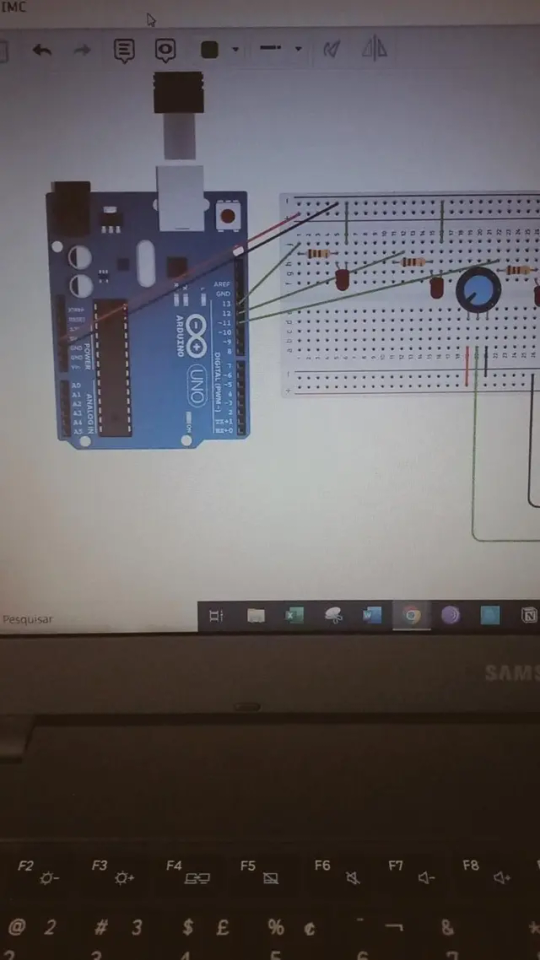

November 7th, 2023
Today was a productive day, I wrote a little bit of an assignment I have to finish, I did some codes for my Data Science project and now I have to optimize these codes for my Arduino project.
And I didn't have time to study Russian again🥲
#engineering#stem#study aesthetic#study motivation#studyblr#studyspo#stem academia#studyinspo#studying#coding#arduino
17 notes
·
View notes